Table of Contents
ToggleGeneration of APAAR ID through UDISE+: Step-by-Step Guide
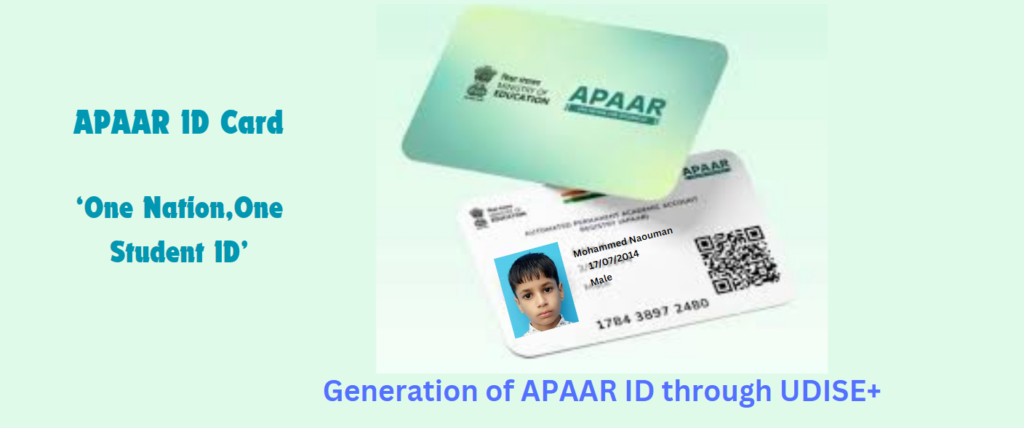
India’s education system is continuously evolving, and one of the most significant recent developments is the “One Nation, One Student ID” initiative. Central to this initiative is the APAAR ID, generated through UDISE+, which stands for Automatic Permanent Academic Account Registry. This unique identification system is designed to streamline educational records for students, ensuring smooth transitions between schools and providing lifelong access to academic data. In this blog, we will outline a comprehensive, step-by-step guide to the generation of APAAR ID through UDISE+, while covering its benefits, the process involved, and its role in modernizing education in India.
What is APAAR ID?
The Automatic Permanent Academic Account Registry (APAAR) is a unique identifier assigned to each student, aimed at tracking academic progress, attendance, and educational records throughout their academic life. APAAR IDs are generated through the UDISE+ (Unified District Information System for Education Plus) platform, an extensive database that gathers information from schools nationwide.
The generation of APAAR ID through UDISE+ ensures that every student has a permanent and unique ID. This ID is linked to their Aadhaar number, allowing seamless transitions across educational institutions, states, and districts, and simplifying administrative processes like admissions, transfers, and record keeping.
Why is APAAR ID Important?
The generation of APAAR ID through UDISE+ offers several benefits, including:
- Unified Student Records: Students have a single, national database that tracks their entire academic journey, simplifying data management for schools.
- Seamless Transfers: Students moving between schools, districts, or states can continue their education without unnecessary paperwork or delays.
- Eligibility for Government Programs: APAAR IDs enable students to easily apply for scholarships, grants, and other government benefits.
- Accurate Monitoring: It allows the government to monitor attendance, performance, and drop-out rates more effectively.
Step-by-Step Guide to the Generation of APAAR ID through UDISE+
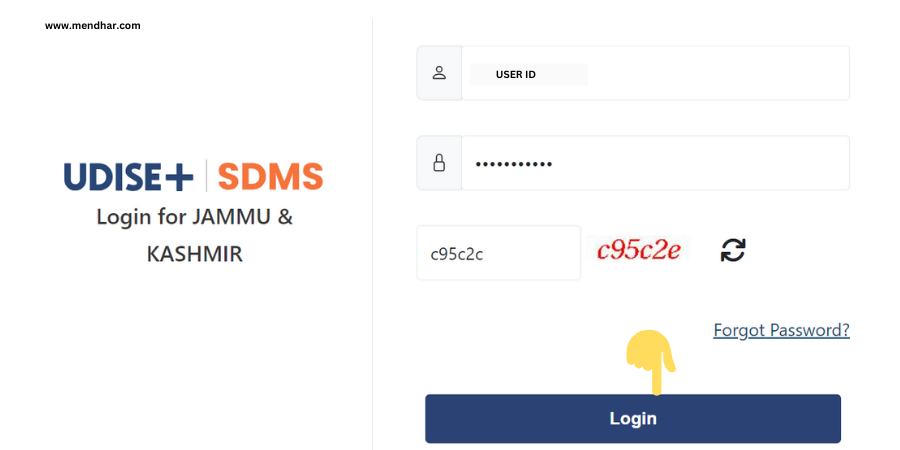
School Registration on UDISE+ The first step is for schools to register on the UDISE+ portal, as they are responsible for generating APAAR IDs for their students. UDISE+ is the backbone of the process, and it allows both public and private schools to upload student data.
- Visit the UDISE+ official portal: https://udiseplus.gov.in/
- Log in with school credentials or register the school if not yet done.
- Verify and update school-related details, including the school code and address.
Collecting Student Data Schools must collect detailed and accurate student information before beginning the generation of APAAR ID through UDISE+. This includes essential personal and academic details.
Required Student Data:
- Full name (as per Aadhaar or other valid ID)
- Aadhaar number (or any other government-issued ID)
- Date of birth, gender, and address
- Parent/guardian details
- Current academic information (class, section, and past academic records)
Ensuring the accuracy of the data at this stage is crucial, as any errors can affect the APAAR ID generation process.
Uploading Data to UDISE+ Once all student data is collected and verified, schools can proceed with uploading it to the UDISE+ portal. UDISE+ provides a bulk upload feature, making it easy for schools to submit multiple students’ data in one go.
- Navigate to the “Upload Student Data” section on the UDISE+ portal.
- Download the data entry template provided by UDISE+ (in Excel or CSV format).
- Enter the student data in the correct format.
- Upload the filled data template and verify it post-upload to ensure there are no errors.
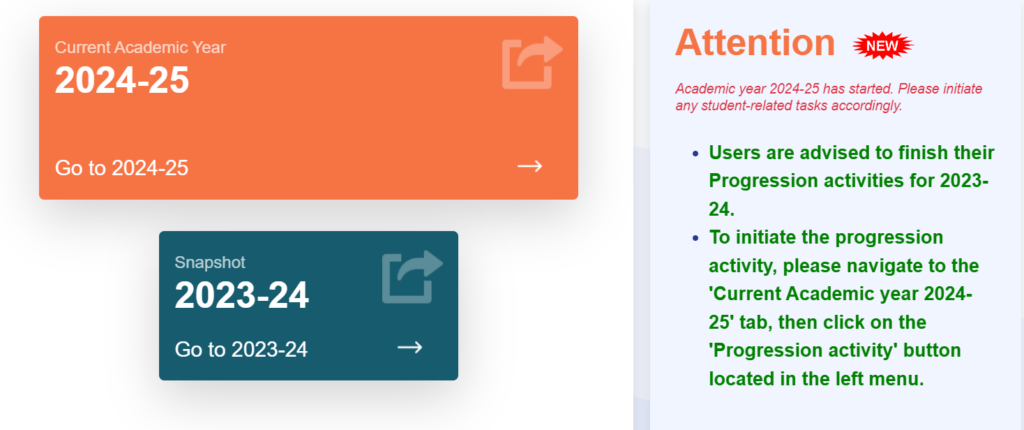
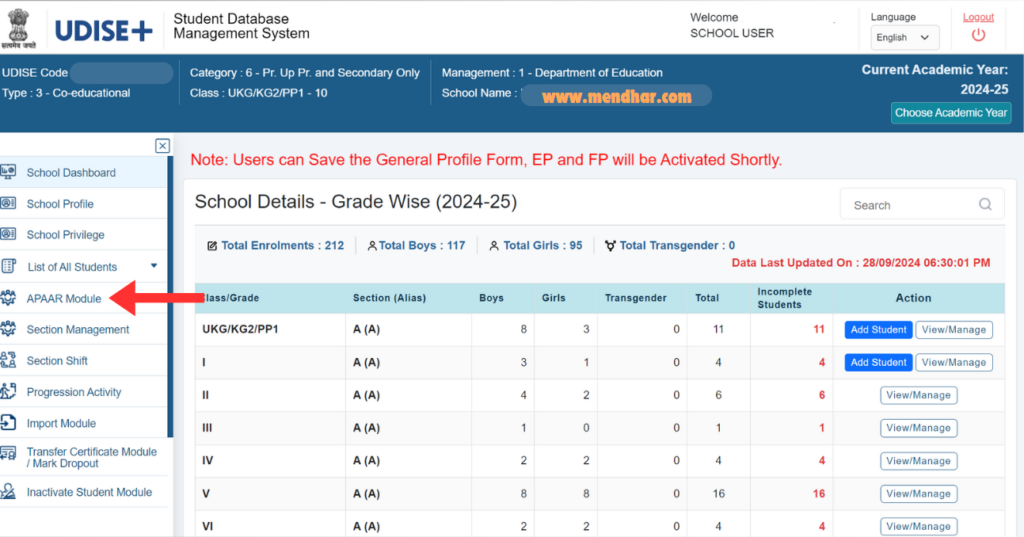
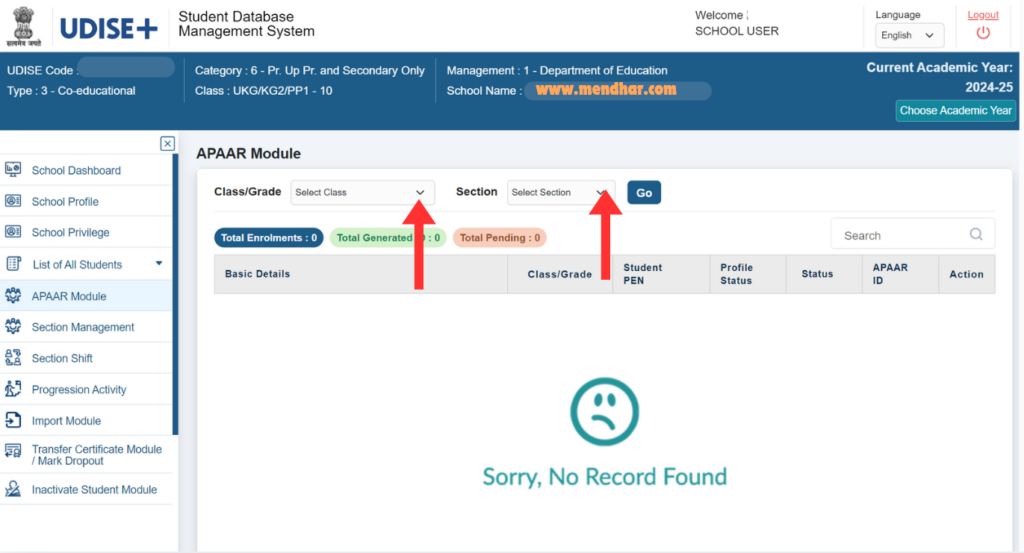
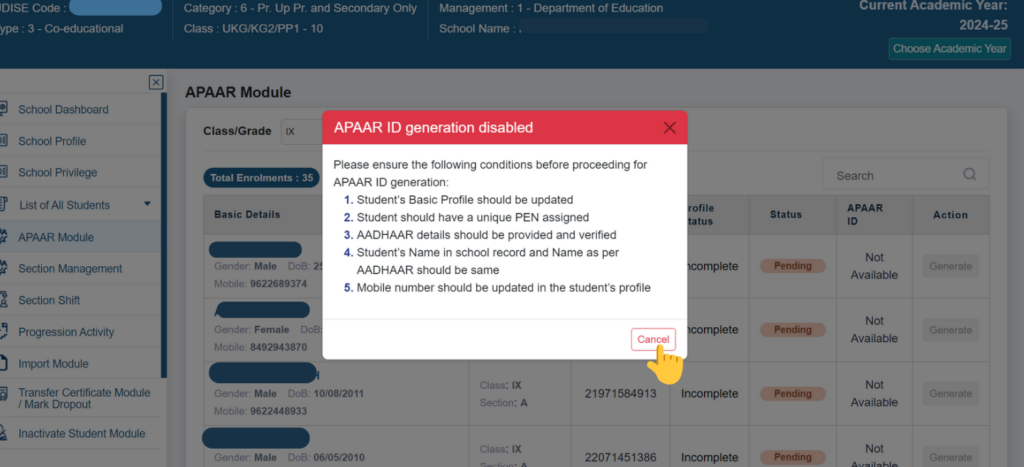
Verification of Data After uploading the student information, UDISE+ verifies the accuracy of the data submitted. Schools are responsible for ensuring that all information is accurate and consistent, particularly in matching the student’s details with their Aadhaar data.
If any discrepancies are found, schools will be notified and asked to make corrections. Only after verification is complete can the generation of APAAR ID through UDISE+ move forward.
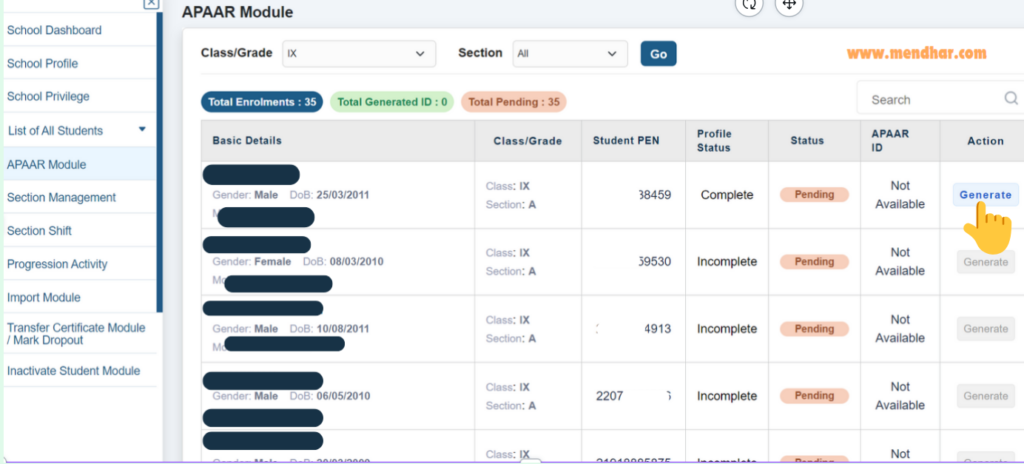
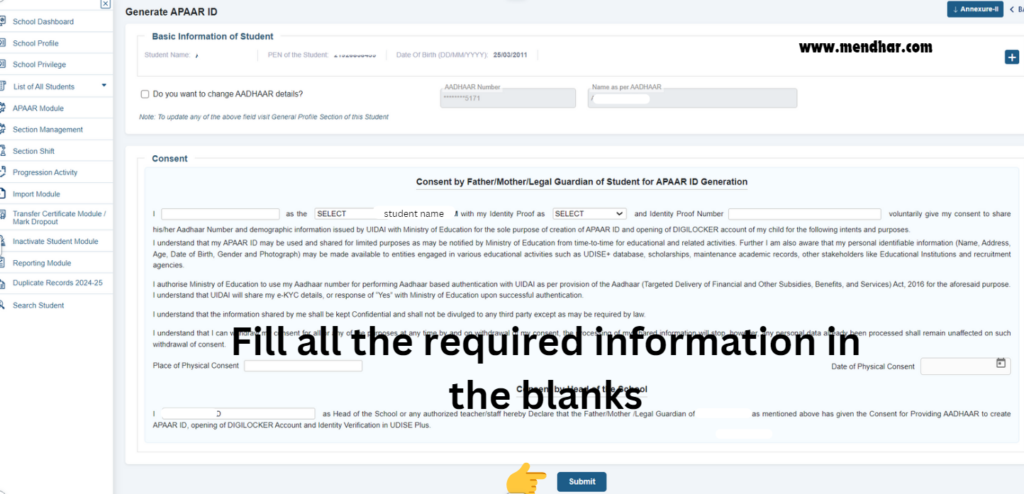
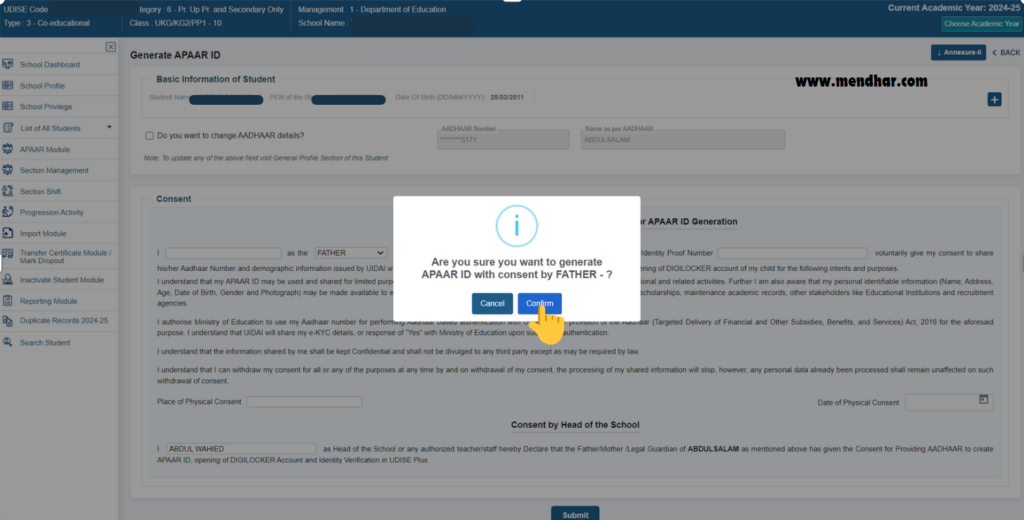
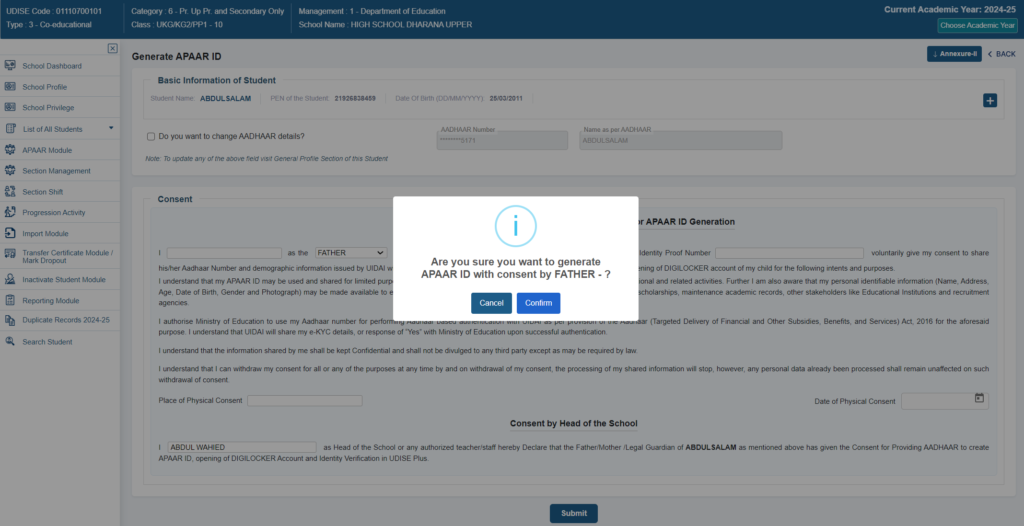
Generation of APAAR ID Once the data has been verified, UDISE+ will automatically generate the Automatic Permanent Academic Account Registry (APAAR) ID for each student. This APAAR ID is unique and permanently linked to the student’s profile throughout their academic journey, ensuring continuity of records even if the student transfers between schools or regions.
Schools can download and distribute the APAAR ID to students. The ID will be available on the UDISE+ portal for future reference.
Linking APAAR ID with Academic Records Following the generation of the APAAR ID, the system automatically links it to the student’s academic records, including attendance, performance, and progress reports. This creates a centralized repository of student data that follows the student throughout their educational journey.
Schools should regularly update this information to ensure the student’s records are accurate and up to date. The generation of APAAR ID through UDISE+ ensures that these records are instantly accessible across different educational platforms and institutions.
Benefits of Generating APAAR ID through UDISE+
The generation of APAAR ID through UDISE+ has numerous benefits that enhance both student mobility and administrative efficiency:
- Centralized Data Management: Schools, districts, and the government have easy access to a student’s complete academic history, eliminating the need for duplicate records or paperwork.
- Aadhaar-linked Accuracy: APAAR IDs are Aadhaar-linked, ensuring the accuracy and authenticity of student records.
- Seamless Student Transitions: Whether a student moves to a different state, district, or school, their academic data moves with them, simplifying the transition process.
- Improved Access to Government Schemes: Students with APAAR IDs are automatically eligible for various government programs like scholarships and mid-day meals, as their data is readily available.
- Reduction in Dropout Rates: With accurate data tracking, the government can better address student dropout rates and provide targeted assistance where needed.
Conclusion:-
The generation of APAAR ID through UDISE+ is a groundbreaking initiative that supports India’s goal of creating a unified, digital education system. By ensuring every student has a unique, permanent ID, it simplifies record management, promotes student mobility, and ensures that academic data is always up to date. Schools, students, and educational authorities must actively engage with this system to reap its full benefits. As part of the One Nation, One Student ID initiative, APAAR IDs will play a vital role in transforming the education landscape, making it more efficient, accessible, and transparent.



Good job sir
Very nice sir ji
Thanks